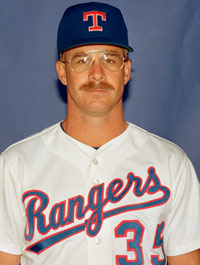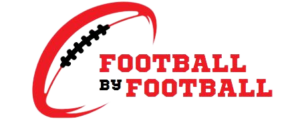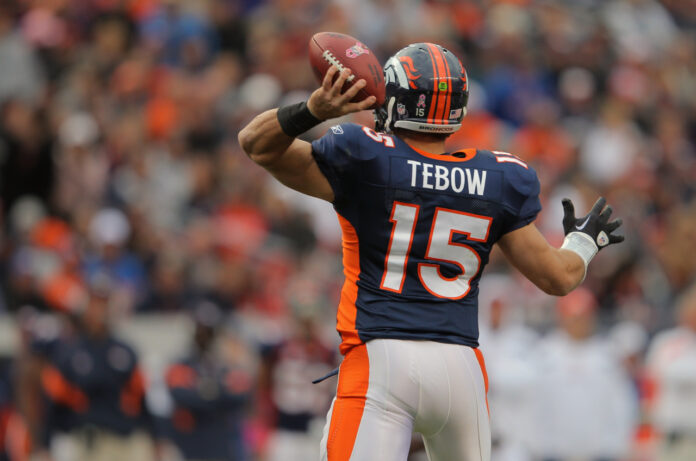Tebow Wants Back in the NFL. His Former Teammate Explores the Hurdles He Must First Overcome.
The perennially circulating debate in the sports world made a resurgence in prominence during the past week:
An NFL team desperately seeking a quarterback is presented with an intriguing prospect. The player in question was one who, in the games he started, led his team to a commendable 8-6 record. The helm was steered in a playoff victory, showcasing the player’s ability under pressure.
A commendable balance in the passing game was exhibited with a tally of 17 touchdowns and a mere nine interceptions.
Athleticism manifested through 12 rushing touchdowns, and a knack for clutch performances was evident in multiple fourth-quarter comebacks. The question arises: Why wouldn’t this be the ideal choice?
This résumé is unmistakably that of Tim Tebow, a familiar name among NFL football fans. However, until the recent week, Tebow had remained absent from NFL team rosters since the 2013 training camp with the New England Patriots.
The spotlight returned when Chip Kelly, in a move that kept outsiders speculating, summoned the former Heisman Trophy winner for a workout.
In a season marked by strategic maneuvers, the news prompted several queries:
Why pursue Tebow now, especially after acquiring the new franchise quarterback, Sam Bradford?
What implications would this have on Mark Sanchez, Tebow’s former New York Jets teammate, who had recently recommitted to the team? Sanchez had previously expressed reluctance to compete with Tebow on the same roster.
How would a quarterback with a career completion rate of 47.9% adapt to Chip Kelly’s system?
Did a favor influence this move to Tom House, the NFL quarterback guru associated with Tebow, or was there a genuine interest in his abilities?
Although Tebow departed Philadelphia without a contract, the resurgence of “what ifs” reignites the age-old debate, regardless of the outcome.
Exploring why Tim Tebow hadn’t received another opportunity and speculating on potential success this time becomes a compelling endeavor.
Having shared the field with Tim in Denver during the 2010 and 2011 seasons, the observer witnessed his journey in the NFL, spanning three seasons.
Considering the extensive time spent together in the QB room, the observer would confidently assert that their understanding of Tim and his playing style surpasses that of any other former teammate.
Tim’s well-known attributes include his unwavering work ethic—he consistently remained on the practice field until the end of sessions. Not only was he a dedicated worker, but he also assumed the role of a vocal leader, expressing a profound passion for football.
Tim proved to be a reliable teammate off the field, seldom venturing out and never finding himself in compromising situations. His commitment to his faith was evident, as he is a God-fearing man unreserved in sharing his feelings about his Lord and Savior.

Tim Tebow appears to embody all the intangible qualities one would desire in a franchise quarterback. Yet, the lingering question persists: Why has he been absent from the NFL?
As mentioned earlier, one notable statistic stands out unfavorably—his completion percentage. Much discourse surrounds Tim’s throwing motion since his NFL debut. Terms like “hitch in his delivery,” “wind-up,” or “too big of a stride” have been used to describe it.
While these critiques may hold merit and could contribute to Tebow’s challenges, they seem insufficient when considered as singular issues.
This is especially apparent when recognizing that the same throwing motion was pivotal in securing two national championships and a Heisman Trophy during his college years.
Notably, this is the same motion that resulted in a 67% completion rate throughout his college career.
So, what changed?
The football remains the same—oblong, only missing a couple of stripes from a college football. The absence of lines can’t account for a 20% drop in completion percentage. Field dimensions are consistent, with hashes just slightly more narrow.
Tebow played with and against NFL-level talent in the SEC, competing in large and raucous venues. Therefore, the stage doesn’t appear to be the issue either.
The reads were made simple [for Tebow]; if there’s a post safety, throw to this guy or run. If two safeties, throw to this guy or run.
One significant challenge in the NFL journey is the transition to the league’s playbook, a narrative observed unfolding.
The shift from a college offensive system to an NFL counterpart is a formidable task for young quarterbacks.
The terminology becomes a new language, demanding the acquisition of communication skills to convey intricate plays to teammates.
The mental and physical demands intensify as quarterbacks are entrusted with setting run-blocking assignments, deciphering pass protection schemes, and identifying hot routes and sight adjustments against dogs or blitzes.
The responsibility extends to making crucial “check-with-me” or audibles at the line of scrimmage.
Physically, the adjustment often includes playing from under center—a substantial change for someone like Tim Tebow.
This entails executing 7-step drops, boots, and play-action pass sets that deviate from the college game’s norms. While the physical adaptation might seem straightforward in theory, the challenge lies in finding the balance and rhythm required to master footwork in the heat of competition consistently.
Tim’s journey is a solid case study, highlighting the more incredible difficulty of the NFL transition than commonly perceived.
Tim, unfortunately, didn’t have the luxury of a gradual learning curve. He was thrust into sporadic play during his rookie year before assuming the starting role in the season’s final three games (2010).
It became apparent that he hadn’t fully grasped the offense mentally or made the necessary physical adjustments in footwork and throwing motion to align with the demands of the NFL game.
In the subsequent offseason, considerable attention surrounded Tim’s efforts to alter his release.
Collaborating with the QB coach, offensive coordinator, quality control, and himself, he sought guidance from anyone willing to offer it.
Even NFL legend John Elway contributed his insights for a period.
The reality, however, is that reprogramming one’s throwing technique after 18 years of repetition is a monumental task.
It requires thousands upon thousands of repetitions, as endorsed by the philosophy of outliers, and it is believed to double that to undo what was once considered ‘mastered.’

At this juncture in Tim’s career, the mastery of his throwing technique had become deeply ingrained, resistant to swift transformation through drills or lessons over a mere couple of months.
When faced with the rapid influx of competitive stimuli, athletes tend to revert to their dominant form of training—what they’ve honed over 18 years, not 18 weeks.
Reports indicate that over the last 18 months, Tim has been under the tutelage of Tom House, a former pitcher, pitching coach, and NFL quarterback guru.
The speaker can attest to this, having worked with Tom during their back rehabilitation and encountering Tim during that period.
Given the intensity of Tom’s work and Tim’s hiatus from game competition, there’s little doubt that Tom could have reconstructed Tim’s throwing motion, accumulating those essential 20,000+ repetitions.
However, the question lingers: Was the throwing motion the root cause of Tim’s accuracy issues? Perhaps in part, but not entirely. In the speaker’s perspective, the primary culprit was mental.
The offensive system had to be streamlined in Denver to leverage Tim’s athleticism without overwhelming him due to his limited experience.
The reads were simplified: if there’s a post safety, throw to this guy or run; if there are two safeties, throw to this guy or run.
This simplistic approach allowed Tim to play fast and navigate the myriad defensive looks that NFL teams present. While lifting him off the ground effectively, it wasn’t a sustainable long-term solution.
The challenge arose when Tim became indecisive about which side of the field to target based on coverage. This hesitation triggered a slower decision-making process, leading to sluggish footwork and rushed throws, ultimately contributing to the issue of inaccurate passes.
The balls exhibited a noticeable wobble, indicative of his body being out of sync and rhythm—factors emphasized by Tom House as crucial for the proper spin of a football, a key element in ensuring accuracy.
It wasn’t solely an accuracy problem; decision-making played a pivotal role, exemplified by instances where Tim had a run play alerted before the snap, yet the situation demanded a pass play or alternate protection due to an all-out blitz.
The first clip, featuring the two-point conversion in the Miami game, should have been alerted to a pass against the obvious blitz.
Despite this, Tim improvised, running it in and making a play. It might seem like a positive outcome to the untrained eye, but missing such a simple check typically doesn’t yield consistent success.
As Tim encountered struggles later, many of these early errors went unrewarded.
The second clip illustrates the game-winning play against the Jets. Facing a Blitz 0, Tim maneuvered around unblocked safety Eric Smith.
While Tim’s ability to make a play is evident, he should have checked the protection and routes. The defense usually capitalizes on such spaces, and while getting away with it earns a SportsCenter highlight, it reinforces an awareness problem bound to resurface.
In both instances, the play should have been alerted to a pass or a different protection but wasn’t. However, Tim showcased his competitive spirit, making football plays and securing victories.
The bottom line was the win, but post-game analysis with coaches and teammates aimed at making corrections, anticipating that other teams wouldn’t allow the same mistakes to go unpunished.
As the mistake persisted, it raised concerns. Despite Tim’s late-game heroics, the success relied on a top-ranked defense and a reliable kicker.
This formula held until defenses adjusted to exploit Tim’s weaknesses. Opponents began deploying an extra defender in the box, playing off man coverage to counter the zone reads and tightening range on the outside.
Tim, forced to throw into tight windows, struggled with his extended-release and indecisiveness, resulting in inaccurate or no throws.
Teams like New England (twice, including the playoffs), Buffalo, Detroit, and Kansas City capitalized on these coverage combinations down the stretch in 2011, securing decisive wins against the team.
These were Tim’s final starts. He was subsequently traded to the New York Jets in 2012, where he played as a wildcat QB and on special teams.
After that season, New England released and signed him in 2013 for training camp. In the demanding quarterback system of New England, Tim’s persisting bad habits were apparent, leading to his release at the final roster cuts.

Fast forward to today, and the time away from the NFL might have been a blessing in disguise for Tim, considering his specific challenges.
This hiatus has allowed him to refine his throwing motion without the immediate pressure of game situations.
Moreover, he’s had the chance to familiarize himself with different systems and gain a broader understanding of the game from a distance.
Overhauling flawed throwing mechanics that impacted accuracy, alongside mastering checks and reading defenses, proved to be an overwhelming task at a certain point in his career.
Teams adapted to Tim’s playing style, and the hope is that he’s made the necessary adjustments in his game during this time away.
As he awaits his next opportunity to play, there’s confidence that it will be a marked improvement over his previous outings, with better preparation. Best wishes are extended to him in his pursuit.
Yet, the looming question remains: Will that opportunity materialize? Only time will tell.

